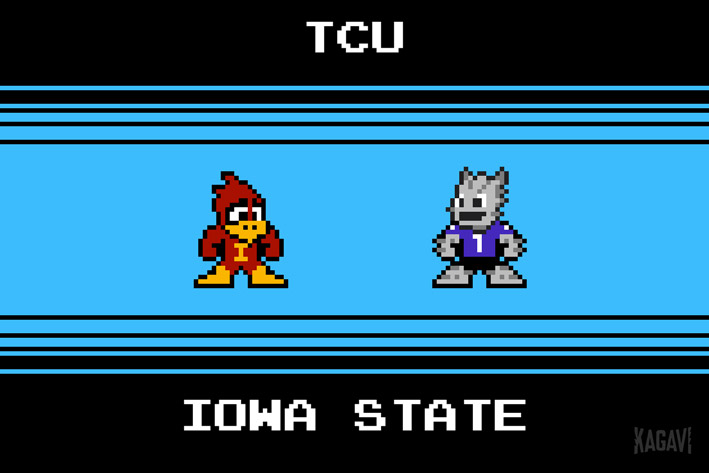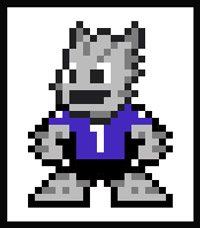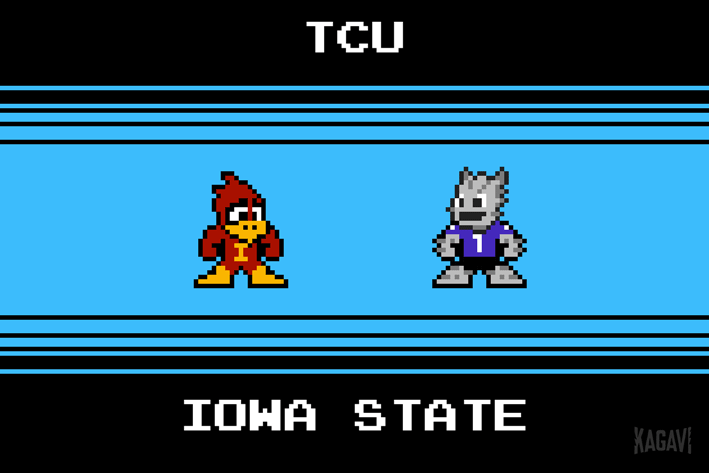
(Story originally posted on SB Nation’s ISU site: Wide Right & Natty Lite.)
_____________
WRNL is proud to present nine weekly articles from Kagavi leading up to the official release of The Adventures of Robot Cy, a fictional 8-bit video game trailer that never was.
In a faraway futuristic time, college football has been taken over by robot mascots. Join Robot Cy as he travels through many thrilling levels to find out who is behind this nefarious plot!
Every week during the conference season, Kagavi will preview the ISU football game using this project as inspiration by asking what power ups could Robot Cy gain by defeating the other Big 12 robot mascots?
_____________
This week our beloved Cyclones are headed back home to the friendly confines of Jack Trice Stadium to receive the undefeated TCU team, currently ranked #3 in the country. The Horned Frogs beat Kansas State last week in a tense game decided during the final minutes. Last Saturday, as we predicted here, the Cyclones found the Texas Tech team completely gassed. Unfortunately, this occurred after the Red Raiders had gained 776 yards in a record-setting performance as they cruised to a 66 – 31 win. (Luckily Robot Cy remains undefeated after gathering the Ghost Riders power up in Lubbock.) The Cyclones kept it pretty close in the TCU game last year, losing in a 55 – 3 squeaker. Perhaps TCU will overlook the ISU squad again this year.
But what if Robot Cy was facing off against Robot Super Frog?
If Robot Super Frog used the best parts of TCU football history to inspire a power up, what would it be? Let’s explore some TCU history.

Two Civil War veterans Addison and Randolph Clark founded AddRan Male and Female College in 1873 in the tiny frontier town of Thorp Spring, Texas by the Brazos River. After eventually realizing the limitations of setting up shop in a small town with no Wal-Mart or phone service, the brothers moved the entire school down the Brazos to Waco in 1895. The following year, the football team was formed and during this period the Horned Frogs nickname was coined along with the school colors. In 1902, the college changed its name to Texas Christian University and in 1910, a mysterious fire (set by jealous Bears?) decimated the school and prompted a final move to Fort Worth where they have been ever since.
The TCU football team eventually followed many of its fellow Texas schools to the Southwest Conference, joining in 1923, and they remained there until the conference broke up in the mid-1990s. During this uncertain time, TCU faced off against Iowa State for the first time in 1995 during Coach Dan McCarney’s first year at ISU. Currently, TCU holds the edge in the relatively new series with 5 wins to just 1 loss.
The Horned Frogs were named after a native lizard, not an amphibian, found all over the Waco campus. Many know about the horned lizard’s capability to squirt blood from its eyes up to four feet away when feeling angry or threatened. No word yet from Ames whether Coach Rhoads plans to adopt this tactic to intimidate the Big 12 referees during the TCU game this weekend. (This unique move was considered as a power up, but shelved due to the squeamish factor.)
TCU’s first stab at creating a mascot was in 1949 with Addy the Fighting Frog (named after co-founder Addison) and it didn’t last. Several decades later, the original Super Frog mascot debuted with bulbous glassy eyes and a perpetually stunned gaze, mouth agape. Future iterations would do little to smooth down Super Frog’s awkward looks, but the university has fully embraced the little tough lizard imagery.
Any examination of TCU football history has to start with Coach Dutch Meyer and his first true star: quarterback Sammy Baugh. Coach Meyer’s first season was in 1935 and he was blessed with the incredibly talented Baugh, who played football, basketball, and baseball at TCU. Meyer and Baugh teamed up to bring the first mythical football national championship to TCU in 1935. Ironically, Baugh was actually thought to be a better baseball player–he signed with the St. Louis Cardinals–but it was football that brought him fame. After two All-American seasons and a fourth place finish in the 1936 Heisman Trophy balloting, Baugh went on to a decorated career with the Washington pro football team.
After Baugh departed, fans braced for a downturn for the 1937 season, but Coach Meyer had another secret weapon. Backup quarterback Davey O’Brien smoothly slid into the starting lineup and the following year, O’Brien would lead TCU to yet another undefeated national championship. After the season, he became the first player to win the Heisman, Maxwell, and Walter Camp trophies in the same year.
Coach Meyer’s powerful 1930s teams established TCU’s reputation in football circles and his colorful antics during games make LSU Coach Les Miles look comatose. Consider this passage from Slingin’ Sam, written by Joe Holley:
“Meyer was a sideline show himself. Always on the move, always talking, he would light one cigarette after another, and sometimes shove the lighted end into his mouth. He was constantly plucking and nibbling grass blades and would jam his expensive Stetson down over his ears until, as one observer put it, ‘he resembled a cat with its head halfway in a salmon can’ . . . By the end of the game he was an emotional basket case and would often break into tears–win, lose or draw. After one victory over traditional rival SMU, he wept unashamedly as the team physician wrenched his hat from around his ears, applied hot and cold towels, and sponged his face.”
In addition to his two star quarterbacks, Coach Dutch Meyer rode a strong defense to multiple titles during the 1930s, a trend that current Coach Gary Patterson has continued. During the 1938 national championship season, the TCU team averaged just over five points allowed per contest. During his reign, Coach Meyer was fond of saying “Fight ‘em until hell freezes over, then fight ‘em on the ice!” To this day, the famous Meyer quote can be found around the TCU football buildings.
Thus, after this brief look at TCU history, it only seems appropriate that the power up for Robot Super Frog should be a homage to the colorful rallying cry of Coach Dutch Meyer during some of TCU’s greatest football years.

The Ice Freeze power up gives Robot Cy the sorely needed ability to freeze opposing team’s offenses in their tracks and get that final crucial stop to secure victory. Think of the 2005 ISU football season–using this would’ve turned a 7 – 5 season into a great 11 -1 or 12 – 0 campaign. If Robot Cy had access to this power up, what other historical football (or basketball) seasons could have turned out much differently?
Are there any other possible power ups that would fit Robot Super Frog? Share them in the comments!
_____________
Visit Kagavi.com or follow them on Twitter at @Kagavi to keep up on all of their projects, including the celebrated Jack Trice series.
